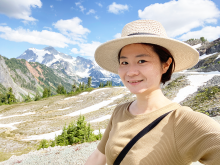Qi Cheng joined the Department of Linguistics in Autumn 2020 and directs the Neuroplasticity and Language Lab, where she researches the critical period and sign languages, and educates about the importance of language input early in life.
From Huzhou to Seattle via Hokkaido, Hong Kong and San Diego
Qi Cheng grew up in Huzhou, China, on Lake Tai, about 2 hours southwest of Shanghai. She came to her current research specialization in a roundabout way. She entered Nanjing University thinking she would become a writer. Her 2011 BA in Chinese language and literature in 2011 entailed much study of ancient Chinese texts, and didn’t include much linguistics until late in the program. But in the middle of her undergraduate studies she participated in a one-year exchange program at Hokkaido University, where she studied Language and Information Science. There she was assigned to a supervising professor, Lee Yeonju, a Korean phonologist, where she was immersed in linguistics, and wrote a term paper comparing Shanghainese and Korean phonology. At the end of her undergraduate studies she had given up on becoming a writer, but was now very interested in linguistics, so she enrolled in Chinese University of Hong Kong. There she received an MA in Chinese Linguistics and Language Acquisition, writing a thesis on the acquisition of the semantics of the Mandarin morpheme ye3 by Cantonese learners, for which the character representing this morpheme is ambiguous in a way it is not in Mandarin. Her supervisor at CUHK was Gladys Tang, and after Qi finished her MA studies, she worked for 2 years for Tang as a Research Assistant at her Centre for Sign Linguistics and Deaf Studies. It was there that she really started working with deaf people learning sign language as a first language. At the end of her RAship, she went to UCSD and studied with Rachel Mayberry, the San Diego area being the premier place for sign language research, critical period, etc. (In case you were wondering, Qi did not overlap with Naja Ferjan Ramírez, another student of Mayberry’s. Qi started in 2014 and Naja finished the previous year.)
After years of focussing on ASL, Qi is resuming research on sign languages of China, where she collaborates with Chinese linguists. Asked to compare ASL in the US with Chinese Sign Language in China, Qi first pointed out that while Ethnologue lists Chinese SL as the main sign language of China, Chinese SL is an official, formal, somewhat artificial language that many deaf people find hard to understand. There are instead many natural sign languages throughout China associated with localities like Hong Kong, Shanghai, etc. that have communities of signers. But relatively few parents in China know about the importance of early language input and it is rare to see them learning a sign language to improve their deaf child’s life.
Qi also collaborates on neuroimaging research with researchers at Johns Hopkins University, where she had been planning a post doc when (surprise!) she was offered a job at the University of Washington in 2020.
Anyone interested in joining the Neuroplasticity and Language Lab should ideally know a sign language but Qi welcomes anyone who is open to or interested in psycholinguistics, acquisition, the role of language input and the role of cognitive skills in the development of language.
